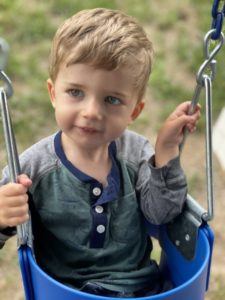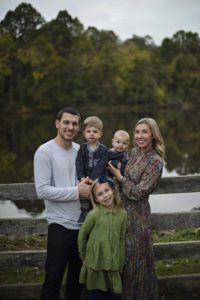At the beginning of our interview, Lindsey Curley explains to me that there is a difference between listening and understanding. Listening is important, of course; she wants people to listen to her story, to learn about her son Finn’s SELENON diagnosis. But the more crucial part is understanding – recognizing the impact of a condition such as this one, the need for research, and how that can help families across the globe. SELENON-related myopathy (also known as SEPN-1, Rigid Spine Disorder, or SELENON-RM) is progressive congenital muscular dystrophy. It is an incredibly rare genetic disorder, affecting only an estimated 1 in every 1-2 million people, and there is still an urgent need for research and advocacy, a need that Lindsey hopes to amplify and fulfill.

Over the last 10-15 years, the understanding of SELENON has grown – but there is still much research to be done. Through launching the Swings for Finn golf tournament, Lindsey and her family have raised over $160,000 to contribute to future research and potential treatment development.
In our interview, Lindsey filled me in on what SELENON is, the family impact of a rare disease, why it is so important to place more focus on rare disease research, and how she sees Swings for Finn evolving in the future.
About SELENON-Related Myopathy
Normally, the SELENON gene, or the SEPN1 gene, produces a protein called Selenoprotein N1. According to Cure CMD, an organization whose mission is to advance research into and provide support for congenital muscular dystrophies:
“Selenoprotein N1 is likely involved in protecting cells against oxidative stress [which] occurs when unstable molecules called free radicals accumulate to levels that damage or kills cells. This protein is highly active in many tissues before birth and may be involved in the formation of muscle tissue [or] for normal muscle function after birth.”
However, the SELENON gene mutations prevent the body from adequately synthesizing Selenoprotein N1, leading to the development of SELENON-related myopathy, or SELENON. Previously known as Rigid Spine Disorder or SEPN-1, SELENON is a rare and progressive congenital muscular dystrophy (CMD), one of its five types. Because it is inherited in an autosomal recessive pattern, those who have SELENON must inherit one defective gene from each parent.
SELENON Symptoms and Characteristics
Cure CMD shares that the symptoms and characteristics associated with SELENON can include:
- Difficulty walking or holding up their heads
- Respiratory insufficiency/difficulty breathing
- Muscle weakness, particularly in the trunk and neck
- Spine rigidity
- Hypotonia (low muscle tone and reduced muscle strength)
- Delayed motor skills
- Scoliosis
- Short stature and difficulty gaining weight
In Finn’s case, Lindsey shares:
“Finn is a very small boy, and he’s unable to gain weight. Eating is a battle. He can do things like walking, and he’s not having respiratory issues currently, but in the next few years, he will need a BiPAP machine while sleeping. Finn falls a lot and unfortunately, when he falls, he falls hard. Due to his core and neck weakness, he often can’t catch himself, plus his falls are frequently headfirst In the future, he won’t be able to do things that require a lot of physical exertion. But we are doing our best to provide care and support while also giving him independence.”
Finn’s Story
Lindsey and Ronnie Curley were incredibly excited to welcome the newest member of their family, Finn, just three years ago in August. The pair, living in Maryland, already had a 3-year-old daughter, Harper. So the chance to expand their family and fill their home with even more love was something that they could not wait to do.

When Finn was first born, he appeared to be – for all intents and purposes – a happy, healthy baby. But, Lindsey explains, she began noticing that Finn didn’t seem to be hitting the correct milestones over the coming months. She shares:
“My daughter and Finn are three years apart. No parent ever wants to compare your children, but I saw that he wasn’t achieving the same milestones as she did. He wasn’t sitting up when he was supposed to, wasn’t crawling, and has always had issues with eating.”
At first, Ronnie and Lindsey took Finn to a pediatrician with their concerns. The doctor said that with some physical therapy, Finn would most likely be fine. But Lindsey couldn’t quite shake her mother’s intuition – something was going on with her son, and she was going to figure out what it was. So she decided to put in a request to visit the Kennedy Krieger Institute in Baltimore to see if they could assist her. Unfortunately, a lengthy waitlist – and the onset of the COVID-19 pandemic – put a slight wrench in their plans.
The Diagnostic Journey
The Kennedy Krieger Institute finally reached out to Lindsey and Ronnie in September 2020, and the Curley family went in to do some neurologic and genetic tests. By this point, Lindsey says, Finn had started walking, so she thought:
“Everything is fine, he’s fine, the milestones were just a little delayed. The doctors began doing genetic tests, and we didn’t believe that anything would pop up, especially because we had done a bunch of testing before the pregnancy.”
So Lindsey was undoubtedly shocked when, in November 2020, the test results showed that Finn had SELENON. Lindsey actually received the test results before the doctor called. When asked about her reaction, she says:
“I don’t recommend reading results before speaking to the doctor, because your mind goes 900 miles an hour, and you’re reading a report that isn’t really in the realm of understanding. I was also pregnant with Rowen [the family’s now 1-year-old son] at the time, so the hormones didn’t help. I was devastated.”
Researching the Condition
After Finn’s diagnosis, Lindsey and Ronnie had many questions about their son’s future – but a discomforting lack of answers. Lindsey shares that one of the hardest parts of processing the diagnosis was that there was not really a roadmap for the future:
“My husband dove right into Google but there’s not really a lot of information out there. Searching on the Internet basically gave us the worst of things and the best of things, but not much to expect. The doctors tried to reassure us that he is on the milder side of SELENON, but also couldn’t tell me what that meant. Does that mean he won’t need a BiPAP or scoliosis surgery? Is he going to need a wheelchair and, if so, when? You have no idea when something might turn into a situation that you have to navigate around.”
During their research, the Curley family did find a Facebook group with less than 300 people in it. In November 2020, at the time of his diagnosis, Finn was the youngest person in the group to be diagnosed with SELENON; many other members were those in their 20s to 40s who had recently been diagnosed. However, since that point, another family has joined whose six-month-old child was recently diagnosed.
While Lindsey finds some comfort in the Facebook group, she also says that she and Ronnie do their best to limit their time on social media. She explains:
“It’s amazing to see all of the ways in which people with SELENON have overcome obstacles. But it’s also bittersweet to know that’s something we may have to prepare for with Finn.”
However, their research did bring them to one huge and helpful resource: Cure CMD. Ronnie and Lindsey immediately signed up for the newsletters and reached out to Cure CMD, and have been connected ever since. Lindsey says that the group offers such helpful support, advice, physician information, and guidance.
In Part 2 of this interview, Lindsey and I discussed the struggles of a rare disease diagnosis, how “Swings for Finn” began, and advice for newly diagnosed families.


